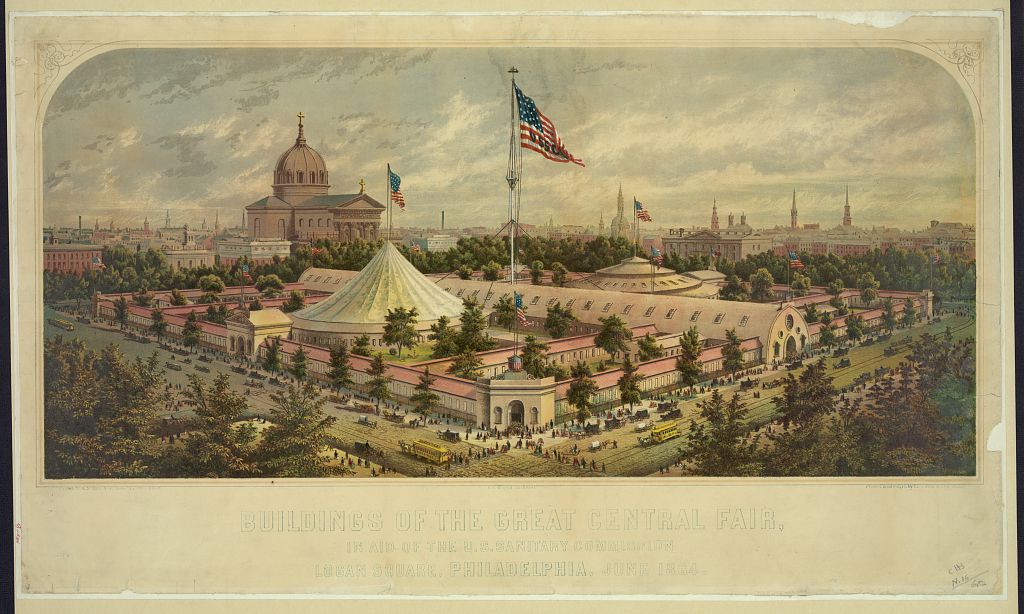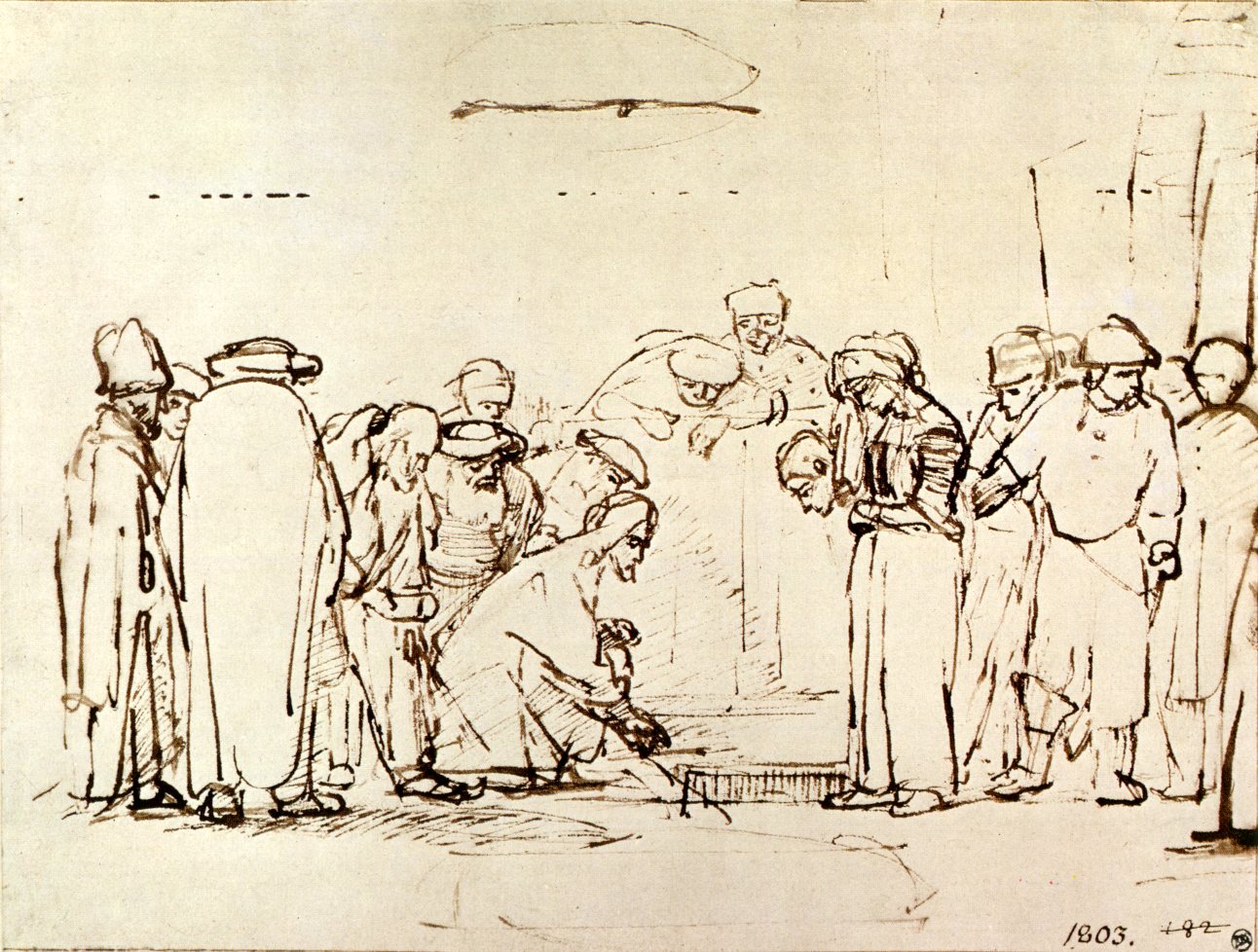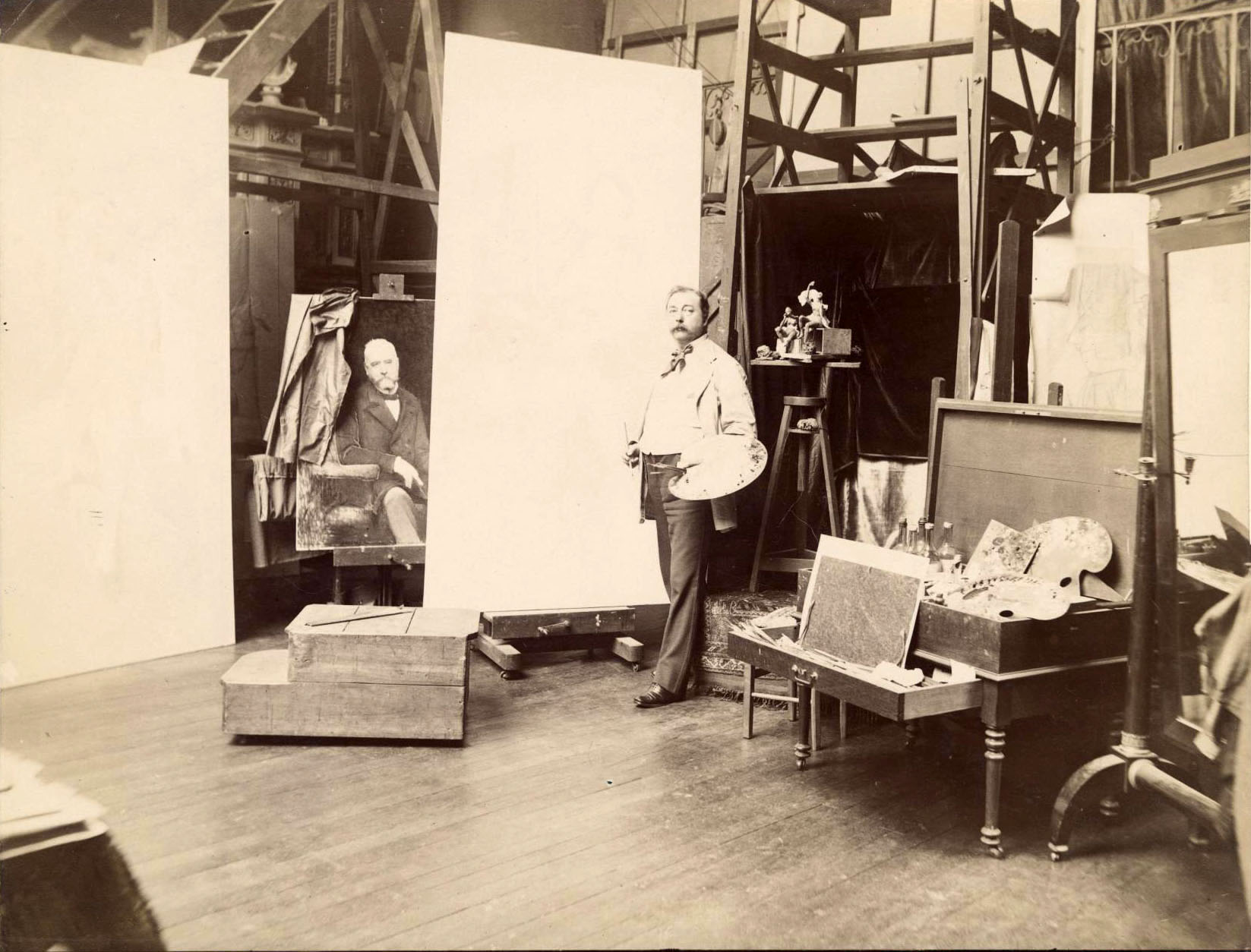|
Colin Campbell Cooper
Colin Campbell Cooper, Jr. (March 8, 1856 – November 6, 1937) was an American Impressionist painter, perhaps most renowned for his architectural paintings, especially of skyscrapers in New York City, Philadelphia, and Chicago. An avid traveler, he was also known for his paintings of European and Asian landmarks, as well as natural landscapes, portraits, florals, and interiors. In addition to being a painter, he was also a teacher and writer. His first wife, Emma Lampert Cooper, was also a highly regarded painter. Background and education Colin Campbell Cooper, Jr. was born in Philadelphia, Pennsylvania, on March 8, 1856, into a well-to-do family of English-Irish heritage. He had four older and four younger siblings. His mother, Emily Williams Cooper, whose ancestor emigrated to the U.S. from Weymouth, England, was an amateur painter in watercolors. His father, Dr. Colin Campbell Cooper, whose grandfather came from Derry, Ireland, was a surgeon and a lawyer with a great appreci ... [...More Info...] [...Related Items...] OR: [Wikipedia] [Google] [Baidu] |
Philadelphia, Pennsylvania
Philadelphia, often called Philly, is the List of municipalities in Pennsylvania#Municipalities, largest city in the Commonwealth (U.S. state), Commonwealth of Pennsylvania, the List of United States cities by population, sixth-largest city in the U.S., the second-largest city in both the Northeast megalopolis and Mid-Atlantic (United States), Mid-Atlantic regions after New York City. Act of Consolidation, 1854, Since 1854, the city has been coextensive with Philadelphia County, Pennsylvania, Philadelphia County, the List of counties in Pennsylvania, most populous county in Pennsylvania and the urban core of the Delaware Valley, the Metropolitan statistical area, nation's seventh-largest and one of List of largest cities, world's largest metropolitan regions, with 6.245 million residents . The city's population at the 2020 United States census, 2020 census was 1,603,797, and over 56 million people live within of Philadelphia. Philadelphia was founded in 1682 by William Penn, ... [...More Info...] [...Related Items...] OR: [Wikipedia] [Google] [Baidu] |
Philadelphia Exposition Of 1876
The Centennial International Exhibition of 1876, the first official World's Fair to be held in the United States, was held in Philadelphia, Pennsylvania, from May 10 to November 10, 1876, to celebrate the 100th anniversary of the signing of the United States Declaration of Independence, Declaration of Independence in Philadelphia. Officially named the International Exhibition of Arts, Manufactures, and Products of the Soil and Mine, it was held in Fairmount Park along the Schuylkill River on fairgrounds designed by Herman J. Schwarzmann. Nearly 10 million visitors attended the exposition, and 37 countries participated in it. Precursor The Great Central Fair on Logan Square in Philadelphia, Pennsylvania, in 1864 (also known as the Great Sanitary Fair), was one of the many United States Sanitary Commission's Sanitary Fairs held during the Civil War. They provided a creative and communal means for ordinary citizens to promote the welfare of Union soldiers and dedicate themselve ... [...More Info...] [...Related Items...] OR: [Wikipedia] [Google] [Baidu] |
Sketch (drawing)
A sketch (ultimately from Greek σχέδιος – ''schedios'', "done extempore") is a rapidly executed freehand drawing that is not usually intended as a finished work.Diana Davies (editor), ''Harrap's Illustrated Dictionary of Art and Artists'', Harrap Books Limited, (1990) A sketch may serve a number of purposes: it might record something that the artist sees, it might record or develop an idea for later use or it might be used as a quick way of graphically demonstrating an image, idea or principle. Sketching is the most inexpensive art medium. Sketches can be made in any drawing medium. The term is most often applied to graphic work executed in a dry medium such as silverpoint, graphite, pencil, charcoal or pastel. It may also apply to drawings executed in pen and ink, digital input such as a digital pen, ballpoint pen, marker pen, water colour and oil paint. The latter two are generally referre ... [...More Info...] [...Related Items...] OR: [Wikipedia] [Google] [Baidu] |
Barbizon School
The Barbizon school of painters were part of an art movement towards Realism in art, which arose in the context of the dominant Romantic Movement of the time. The Barbizon school was active roughly from 1830 through 1870. It takes its name from the village of Barbizon, France, on the edge of the Forest of Fontainebleau, where many of the artists gathered. Most of their works were landscape painting, but several of them also painted landscapes with farmworkers, and genre scenes of village life. Some of the most prominent features of this school are its tonal qualities, color, loose brushwork, and softness of form. The leaders of the Barbizon school were: Théodore Rousseau, Charles-François Daubigny, Jules Dupré, Constant Troyon, Charles Jacque, and Narcisse Virgilio Díaz. Jean-François Millet lived in Barbizon from 1849, but his interest in figures with a landscape backdrop sets him rather apart from the others. Jean-Baptiste-Camille Corot was the earliest o ... [...More Info...] [...Related Items...] OR: [Wikipedia] [Google] [Baidu] |
Landscape Art
Landscape painting, also known as landscape art, is the depiction of natural scenery such as mountains A mountain is an elevated portion of the Earth's crust, generally with steep sides that show significant exposed bedrock. Although definitions vary, a mountain may differ from a plateau in having a limited summit area, and is usually higher th ..., valleys, trees, rivers, and forests, especially where the main subject is a wide view—with its elements arranged into a coherent composition. In other works, landscape backgrounds for figures can still form an important part of the work. Sky is almost always included in the view, and weather is often an element of the composition. Detailed landscapes as a distinct subject are not found in all artistic traditions, and develop when there is already a sophisticated tradition of representing other subjects. Two main traditions spring from Western painting and Chinese art, going back well over a thousand years in both cas ... [...More Info...] [...Related Items...] OR: [Wikipedia] [Google] [Baidu] |
Académie Vitti
The Académie Vitti was an art school in Paris, France. It was founded and operated by a family of Italian artists' models from the Valle di Comino to the south of Rome. The academy was progressive in its support for women artists, and gained a high reputation. Teachers included Paul Gauguin and Frederick William MacMonnies. History The Académie Vitti, a private art school at 49, boulevard du Montparnasse, Paris was founded in 1889 by Cesare Vitti, his wife Maria Caira, and her sisters Anna Caira and Jacinta Caira. Cesare Vitti came from Casalvieri, a village in the Valle di Comino close to Atina in the mountains south of Rome. He began as an artist's model, then became a painter and sculptor himself. The three Caira sisters, their cousin Carmela and their brother Antonio came from nearby Gallinaro. They moved to Paris and worked as models for painters, sculptors and photographers. Antonio Caira posed as a blacksmith for the French 100 franc banknote drawn by Luc-Olivier M ... [...More Info...] [...Related Items...] OR: [Wikipedia] [Google] [Baidu] |
Académie Delécluse
The Académie Delécluse was an atelier-style art school in Paris, France, founded in the late 19th century by the painter Auguste Joseph Delécluse. It was exceptionally supportive of women artists, with more space being given to women students than to men. History The academy was founded by the French painter Auguste Joseph Delécluse in the late 19th century, and seems to have been in business starting in either 1884 or 1888. The school moved locations several times before establishing a permanent location in Montparnasse on the 84 Rue Notre Dame des Champs. Like the Académie Julian, Académie Colarossi, and Académie Vitti, this school accepted women students. Men and women were trained separately, and it had two studios for women and only one for men. This proved to be particularly popular among English and American women artists. During its heyday, it was one of the four best-known ateliers in Paris, but its influence and ability to attract good students waned in the early ... [...More Info...] [...Related Items...] OR: [Wikipedia] [Google] [Baidu] |
Jules Joseph Lefebvre
Jules Joseph Lefebvre (; 14 March 183624 February 1911) was a French figure painter, educator and theorist. Early life Lefebvre was born in Tournan-en-Brie, Seine-et-Marne, on 14 March 1836. He entered the École nationale supérieure des Beaux-Arts in 1852 and was a pupil of Léon Cogniet. Career He won the prestigious Prix de Rome in 1861. Between 1855 and 1898, he exhibited 72 portraits in the Paris Salon. Many of his paintings are single figures of beautiful women. Among his best portraits were those of M. L. Reynaud and the Prince Imperial (1874). In 1891, he became a member of the French Académie des Beaux-Arts. He was professor at the Académie Julian in Paris. Lefebvre is chiefly important as an excellent and sympathetic teacher who numbered many Americans among his 1500 or more pupils. Among his famous students were Fernand Khnopff, Kenyon Cox,Oxford Art Online, "Lefebvre, Jules" Félix Vallotton, Ernst Friedrich von Liphart, Georges Rochegrosse, the Scottish-born ... [...More Info...] [...Related Items...] OR: [Wikipedia] [Google] [Baidu] |
William-Adolphe Bouguereau
William-Adolphe Bouguereau (; 30 November 1825 – 19 August 1905) was a French academic painter. In his realistic genre paintings, he used mythological themes, making modern interpretations of classical subjects, with an emphasis on the female human body. During his life, he enjoyed significant popularity in France and the United States, was given numerous official honors, and received top prices for his work. As the quintessential salon painter of his generation, he was reviled by the Impressionist avant-garde. By the early twentieth century, Bouguereau and his art fell out of favor with the public, due in part to changing tastes. In the 1980s, a revival of interest in figure painting led to a rediscovery of Bouguereau and his work. He finished 822 known paintings, but the whereabouts of many are still unknown. Life and career Formative years William-Adolphe Bouguereau was born in La Rochelle, France, on 30 November 1825, into a family of wine and olive oil merchants.Wissman ... [...More Info...] [...Related Items...] OR: [Wikipedia] [Google] [Baidu] |
Henri Lucien Doucet
Henri Lucien Doucet (23 August 1856 – 31 December 1895) was a French figure and portrait painter and pastellist, born in Paris. Biography Doucet studied under Lefebvre and Boulanger, and in 1880 won the Prix de Rome. In 1888, he taught at Académie Julian His pictures are usually piquant, sparkling representations of modern life, eminently Parisian in style, but the audacious realism of his earlier work is not maintained in his later, which is somewhat characterless. His portraits in pastel are also notable. His most widely known picture is ''Après le bal'' (''After the Ball'', 1889). Other excellent examples are the portraits of ''Celestine Galli-Marie as Carmen'' (1884, Marseille Museum), ''La princesse Mathilde Laetitia Wilhelmine Bonaparte'' and ''My Parents'' (1890, Lyons Museum), ''A Spanish Woman'' (Pontoise Museum), and ''Nude Figure'' (1890). He was awarded a first-class medal for pastel in 1889 and the Legion of Honour in 1891. His painting ''A Skating Party' ... [...More Info...] [...Related Items...] OR: [Wikipedia] [Google] [Baidu] |
Paris
Paris () is the capital and most populous city of France, with an estimated population of 2,165,423 residents in 2019 in an area of more than 105 km² (41 sq mi), making it the 30th most densely populated city in the world in 2020. Since the 17th century, Paris has been one of the world's major centres of finance, diplomacy, commerce, fashion, gastronomy, and science. For its leading role in the arts and sciences, as well as its very early system of street lighting, in the 19th century it became known as "the City of Light". Like London, prior to the Second World War, it was also sometimes called the capital of the world. The City of Paris is the centre of the Île-de-France region, or Paris Region, with an estimated population of 12,262,544 in 2019, or about 19% of the population of France, making the region France's primate city. The Paris Region had a GDP of €739 billion ($743 billion) in 2019, which is the highest in Europe. According to the Economis ... [...More Info...] [...Related Items...] OR: [Wikipedia] [Google] [Baidu] |
Brittany
Brittany (; french: link=no, Bretagne ; br, Breizh, or ; Gallo: ''Bertaèyn'' ) is a peninsula, historical country and cultural area in the west of modern France, covering the western part of what was known as Armorica during the period of Roman occupation. It became an independent kingdom and then a duchy before being united with the Kingdom of France in 1532 as a province governed as a separate nation under the crown. Brittany has also been referred to as Little Britain (as opposed to Great Britain, with which it shares an etymology). It is bordered by the English Channel to the north, Normandy to the northeast, eastern Pays de la Loire to the southeast, the Bay of Biscay to the south, and the Celtic Sea and the Atlantic Ocean to the west. Its land area is 34,023 km2 . Brittany is the site of some of the world's oldest standing architecture, home to the Barnenez, the Tumulus Saint-Michel and others, which date to the early 5th millennium BC. Today, the h ... [...More Info...] [...Related Items...] OR: [Wikipedia] [Google] [Baidu] |









